Otherworldly Observations
A few years ago, back when this idea of the otherworld bleeding through began to make its way into Pagan/Witch discourse, I had a curious incident at the side of a river with a witchy friend. We’d been on a walk together as we often did back then in the pre-plague years, end eventually (unsurprisingly) we’d begun to “talk shop.” You see, both of us had noticed the uptick in otherworldly activity, in a similar way to how hunters are often the first to notice disease in deer.

Now, please don’t get me wrong. I’m not comparing the Other with disease here (I wouldn’t dare). I’m just saying that as magical practitioners, we tend to be among the first to notice this kind of thing.
But we were both also getting messages from multiple people. Moreover, these were often from people who didn’t ordinarily experience our kind of strangeness, and that stood out.
At some point in our discussion, I mentioned the fact that a witch’s knowledge and power was believed to come from otherworldly sources where I’m from. And I wondered what the effects of this otherworldly “bleed” would have on magic and what we humans can do with magic. Naturally (because I’m an idiot like this), I grabbed a stick and drew a sigil I use when creating portals into the sand and silt of the riverbank.
The effect was almost instantaneous: a shifting sensation that used to take more effort to achieve.
I closed it and scrubbed it from the sand almost as soon as my friend and I noticed the shift. But I’ve been musing about the changing limits of magical possibility, consensus, and opposition ever since.
John’s Rising Currents
Discourse is a funny old thing. Sometimes we can have an observation or thought sitting in the soil of our mind for a long time without writing about it. But then, something will happen to water it, and it’ll take root and grow.
(As an aside, it’s interesting how we refer to events that spark action as “precipitating events.” Soil and seeds. Soil and seeds.)
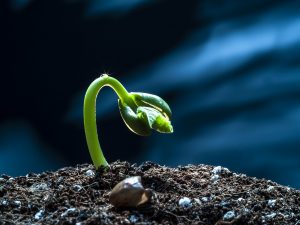
I’m a firm believer that most things have their season. And if the blog John Beckett posted this morning is anything to go by, then this subject’s season has come.
In The Currents of Magic are Getting Stronger, John Beckett makes the same observation I did at the side of that river. Ironically, he uses the analogy of a river running higher and faster to explain his observation that the “currents” of magic are getting stronger and enabling an increase in possibility/greater results. He also goes on to cautiously suggest some possible causes, and this is where I feel like I have something to add.
Magic and the Otherworldly
I’ve blogged about this before, but in the historical witchcraft traditions where I’m from, the source of the witch’s power and knowledge was otherworldly. This is where we get into familiars and hierarchy. These are all complex topics, and more than I can cover in this blog, so I encourage you to read the posts I’ve linked here if you want to go deeper. That’s not to say that what we call the “otherworldly” is the only possible source of magic and knowledge though, nor the only possible framework through which these changes can be understood.
We also cannot ignore the fact that most of the discussion on this topic is coming from US sources. I’m not saying that strange things aren’t also happening elsewhere—some of my mother’s stories from back in Lancashire have been decidedly stranger than usual of late. But we also cannot assume that just because this stuff is happening here, it’s happening everywhere.
In my opinion, an important consideration in this discussion of how widespread or localized this “trend” is, boils down to the relationship between a culture and the otherworldly beings they interact with. ( Assuming the relationship between Otherworldly beings and magic is found within those cultures in the first place.)
Fairy-like beings are found in lore pretty much all over the world, but not all cultures have responded in the same way to their presence over time. Some cultures—such as many Western European cultures—equated them with demons and/ fallen angels, destroyed their sanctuaries, and drove them out after humans converted to Christianity (LeCouteux, Claude. Demons and Spirits of the Land. Pp. 23-28, 68-80).
And I’m not saying that folk practices involving the otherworldly didn’t still exist, of course. We know they did. But as I’ll hopefully make clear in the next section, consensus (like all stories) is a powerful and often binding thing.
This process wasn’t limited to Western Europe either. If Cotton Mather is to be believed in his Wonders of the Invisible World, early colonizers in what would become the US also drove out “devils.” He even goes on to blame the apparent preponderance of witches in Salem on a counterattack by the devils, thus retaining that link between witches and the Otherworldly in his interpretation of events.
The otherworld is bleeding through, the devils are coming back, and they’re bringing us witches with them?
However in some places, maybe the Otherworld didn’t need to bleed back in from anywhere else at all.
Reality, Consensus, Possibility, and Feedback Loops
Another story now. Back in the mid-2000s, I came across an interesting interaction at a Pagan Conference in England between a gentleman from an African country (I didn’t get chance to ask him which), and a vendor who was selling these tacky, crystal-encrusted “wish books.” For her, even as someone who considered herself a witch, these books were just a bit of fun and to be commonly understood as such. There was no real expectation that writing your wishes in them would yield any concrete results. But her potential customer clearly had far greater expectations of the “wish book” than her and kept asking her in a deadly serious voice if it really worked.
As you might imagine, this became increasingly more uncomfortable the longer it went on.
To me though, as an observer, I couldn’t help but be struck by the wildly different expectations of magic that were revealed through this interaction. Again, this is something I’ve written about before, but much of what we commonly call “reality” is more accurately described as consensus. We take in far more information through our ordinary senses per second than we can even be conscious of, let alone store in our memories. Moreover, studies have shown that we’re more likely to become conscious of/retain the information that aligns with our existing beliefs and biases.
This is impossible to separate from consensus. I believe that consensus, in a sense, both delineates and limits the boundaries of possibility.
From this perspective, the more people that experience and/or interact with the strange and Otherworldly, the more the consensus that THIS DOES NOT HAPPEN IN “REALITY” is challenged. And over time if enough people start to have these experiences, the consensus of a culture shifts to include them in the realm of possibility. This in turn, creates a kind of feedback loop in which that consensus is progressively widened. (A process that is not so different from what you find in a propaganda campaign.)

This is theory, but I would argue we have historical proof of the reverse: the binding effects of consensus.
I’ve written about this before, but we can see this in how concepts of dreaming change in Northwestern Europe after the advent of Christianity. People went from considering dreams a place where they could encounter the dead and otherworldly in a concrete way, to a state of consciousness in which people only experience nonsensical or anxiety-driven scenarios.
(Again, another way of driving out the otherworldly, I might add.)
This is all very exciting to think about, but I think we need to also be cautious here too.
The Other Side of the Coin
Within the Pagan and Witch communities, I think there is a tendency to assume that we are the only ones out there working magic. We forget that Christians also have their magic, and that a more forgiving consensus is also going to benefit them as well.
Unfortunately for us, they tend to be very much against our kind of magic, and they still largely label the Other as “demonic.” They also have an established tradition of weaponized “prayer” in the form of “prayer warriors,” who often work together in groups and are capable of a level of faith and zeal very few Pagans and Witches can muster.
Another area of concern is that I suspect a lot of the more “fringe” Christians are feeling the same uptick in activity as we are. I’m far from an expert on this subject, but I keep an eye on some of these groups as part of my omen-taking, and this is something I’ve noticed. There seems to have been an uptick in videos of “demonic possession” over the past few years. And talk of spiritual warfare against demons and witches seems to have become more common. (Here’s a recent example.) There have also been large events such as the Jericho March earlier this year. Participants of the march blew shofarim and marched around the Capitol building seven times while praying- a clear imitation of the Israelite siege of the city of Jericho. The next day was 1/6, in case you were wondering about their intentions.
If there’s anything we can learn from history when it comes to religious fundamentalists of a certain kind, it’s that this usually doesn’t go well for us. The more people believe in the possibilities of magic in general, the more they tend to blame magic (and practitioners) when things go wrong. So, the Otherworldly may be more present, and “currents of magic” may be rising and growing in strength, but they’re not without a brewing backlash.
I just hope we don’t wind up in a place where humans meet the same fate as books.



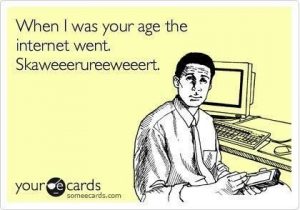


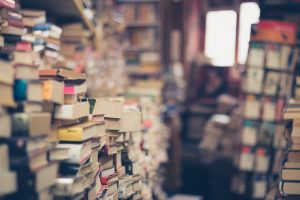


 something being unleashed into the world, and I knew then and there that what I had spoken into the world would come to pass; that my victim would fall from his ladder at work.
something being unleashed into the world, and I knew then and there that what I had spoken into the world would come to pass; that my victim would fall from his ladder at work.
 is sufficiently complete for now.
is sufficiently complete for now. “Father of Galdr” (as he was named in Baldrs Draumar) is both explicit and well-established, and not just in the ON sources either (Simek 242). Woden is the only Heathen god to be mentioned in the OE magico-medical manuscripts; it is he who rests at the center of the so-called “Nine Herbs Charm” found in the Lacnunga. And it is Woden who is depicted chanting a spell over an injured horse’s leg in the Second Merseburg Charm (Waggoner, xv).
“Father of Galdr” (as he was named in Baldrs Draumar) is both explicit and well-established, and not just in the ON sources either (Simek 242). Woden is the only Heathen god to be mentioned in the OE magico-medical manuscripts; it is he who rests at the center of the so-called “Nine Herbs Charm” found in the Lacnunga. And it is Woden who is depicted chanting a spell over an injured horse’s leg in the Second Merseburg Charm (Waggoner, xv).
 “These men asked Halfdan to attack Hardbeen and his champions man by man; and he not only promised to fight, but assured himself the victory with most confident words. When Hardbeen heard this, a demoniacal frenzy suddenly took him; he furiously bit and devoured the edges of his shield; he kept gulping down fiery coals; he snatched live embers in his mouth and let them pass down into his entrails; he rushed through the perils of crackling fires; and at last, when he had raved through every sort of madness, he turned his sword with raging hand against the hearts of six of his champions. It is doubtful whether this madness came from thirst for battle or natural ferocity.”
“These men asked Halfdan to attack Hardbeen and his champions man by man; and he not only promised to fight, but assured himself the victory with most confident words. When Hardbeen heard this, a demoniacal frenzy suddenly took him; he furiously bit and devoured the edges of his shield; he kept gulping down fiery coals; he snatched live embers in his mouth and let them pass down into his entrails; he rushed through the perils of crackling fires; and at last, when he had raved through every sort of madness, he turned his sword with raging hand against the hearts of six of his champions. It is doubtful whether this madness came from thirst for battle or natural ferocity.”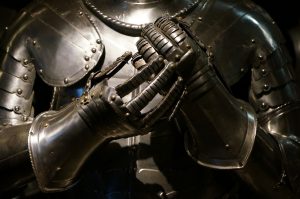

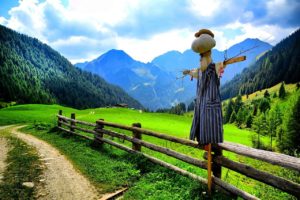 de France. In one of her lais, Bisclavret, a man-turned-werewolf is prevented from returning to his shape of birth by an unfaithful lover hiding his clothes. You see, when it comes to masking and its sibling, shapeshifting,
de France. In one of her lais, Bisclavret, a man-turned-werewolf is prevented from returning to his shape of birth by an unfaithful lover hiding his clothes. You see, when it comes to masking and its sibling, shapeshifting,  ”Woden worhte weos, wuldor alwalda,
”Woden worhte weos, wuldor alwalda, the island of Sámsey. There they encounter a ‘tree-man’ who speaks to them of his purpose and origin. He was the product of sacrifice, and had been made to bring about the deaths of men in the southern part of Sámsey. But over the years, he’d become overgrown and his clothes and flesh rotted away.
the island of Sámsey. There they encounter a ‘tree-man’ who speaks to them of his purpose and origin. He was the product of sacrifice, and had been made to bring about the deaths of men in the southern part of Sámsey. But over the years, he’d become overgrown and his clothes and flesh rotted away. makes the sacrifices until he receives a favorable oracle when he has a piece of driftwood brought in and fashioned into the shape of a wooden man. Then with “the monstrous witchcraft and python’s breath” of those two sisters, as well as the heart of a man sacrificed for the purpose and the proper attire for a man, they sent their tree-man, now named Þorgarðr, into the world to kill Þorleif (North 93 – 95).
makes the sacrifices until he receives a favorable oracle when he has a piece of driftwood brought in and fashioned into the shape of a wooden man. Then with “the monstrous witchcraft and python’s breath” of those two sisters, as well as the heart of a man sacrificed for the purpose and the proper attire for a man, they sent their tree-man, now named Þorgarðr, into the world to kill Þorleif (North 93 – 95).
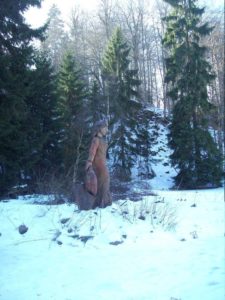 Hulle set not far from Wintersbach. And this is the tale that led me down the rabbithole so to speak. First came the spinning, and then more research and a pilgrimage of sorts to the Hollenteich up on the Hoher Meißner. There, on a frozen pond before a modern statue, I had a deeply holy (and unexpected) experience.
Hulle set not far from Wintersbach. And this is the tale that led me down the rabbithole so to speak. First came the spinning, and then more research and a pilgrimage of sorts to the Hollenteich up on the Hoher Meißner. There, on a frozen pond before a modern statue, I had a deeply holy (and unexpected) experience. But one day, while spinning at the side of a well, she accidentally drops her spindle into the well after pricking her finger.
But one day, while spinning at the side of a well, she accidentally drops her spindle into the well after pricking her finger. made sure to cut herself and throw a spindle into the well before she herself took the plunge is perhaps telling.
made sure to cut herself and throw a spindle into the well before she herself took the plunge is perhaps telling. First the dead pass over a thorny moor (‘Whinny muir’) that will prick them. Then they must pass over the ‘Brig o’Dread’. And then finally, because this is a Christian song, they must roast in Purgatory for a while. But at every turn, these tortures can be mitigated by one’s behavior in life. Those who gave the charity of socks and shoes (‘hosen or shoon’) will find socks and shoes to protect them on the thorny moor. Those who gave the charity of food and drink, will not be shrunk and burned by Purgatory’s fires. (The Brig o’Dread is its own challenge, and I’ll be taking a look at it in the next section.)
First the dead pass over a thorny moor (‘Whinny muir’) that will prick them. Then they must pass over the ‘Brig o’Dread’. And then finally, because this is a Christian song, they must roast in Purgatory for a while. But at every turn, these tortures can be mitigated by one’s behavior in life. Those who gave the charity of socks and shoes (‘hosen or shoon’) will find socks and shoes to protect them on the thorny moor. Those who gave the charity of food and drink, will not be shrunk and burned by Purgatory’s fires. (The Brig o’Dread is its own challenge, and I’ll be taking a look at it in the next section.)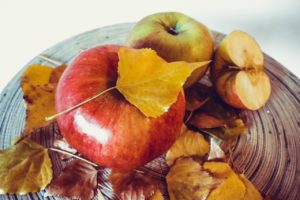 century Icelandic poet Þórbjörn Brúnason made a curious mention of the ‘apples of Hel’. And apples also featured as grave goods in both Scandinavian and early English graves. But apples are not only associated with the dead in Norse lore. The apple seems to be both a food for the dead and a substance of renewal for the gods.(Davidson, Gods and Myths of Northern Europe, 165-166).
century Icelandic poet Þórbjörn Brúnason made a curious mention of the ‘apples of Hel’. And apples also featured as grave goods in both Scandinavian and early English graves. But apples are not only associated with the dead in Norse lore. The apple seems to be both a food for the dead and a substance of renewal for the gods.(Davidson, Gods and Myths of Northern Europe, 165-166). ”Readers familiar with Neil Gaiman’s Sandman series might find some parallels here: the mundus imaginalis is like “The Dreaming,” a realm populated by the dreaming of every being, living or dead, god or human or plant, where each “place” has a geography only inasmuch as it’s necessary for those who visit to travel within it and find the same place again (or visit a place another once visited). In fact, Gaiman likely stole the entire idea for his cosmology from Corbin’s essay.”
”Readers familiar with Neil Gaiman’s Sandman series might find some parallels here: the mundus imaginalis is like “The Dreaming,” a realm populated by the dreaming of every being, living or dead, god or human or plant, where each “place” has a geography only inasmuch as it’s necessary for those who visit to travel within it and find the same place again (or visit a place another once visited). In fact, Gaiman likely stole the entire idea for his cosmology from Corbin’s essay.” of map to this road to the afterlife. First the person dies/passes through water, and then they encounter two different trials. Yet the trials in both sources are far from insurmountable, presenting little problem for the compassionate person.
of map to this road to the afterlife. First the person dies/passes through water, and then they encounter two different trials. Yet the trials in both sources are far from insurmountable, presenting little problem for the compassionate person.
 and discussion. So if you’ve got an hour or so (it’s probably going to be between 1-2 hours) on 9/15 at around 3pm, join me for a crazed exploration of the history, purpose, and ways in which magic circles can be tweaked. Can’t make it? The class will be recorded so participants can listen later!
and discussion. So if you’ve got an hour or so (it’s probably going to be between 1-2 hours) on 9/15 at around 3pm, join me for a crazed exploration of the history, purpose, and ways in which magic circles can be tweaked. Can’t make it? The class will be recorded so participants can listen later!

 Legitimate lineages (however they’re judged) can be excellent for a number of reasons though. Because not only do you have access to a far more systematic way of learning, but you also have the safety nets of more experienced elders as well as the lineage itself. If you are interested in a tradition that has lineages then you should absolutely do the work and enter in the correct way. In some cases, it can actually be dangerous to you if you don’t.
Legitimate lineages (however they’re judged) can be excellent for a number of reasons though. Because not only do you have access to a far more systematic way of learning, but you also have the safety nets of more experienced elders as well as the lineage itself. If you are interested in a tradition that has lineages then you should absolutely do the work and enter in the correct way. In some cases, it can actually be dangerous to you if you don’t.
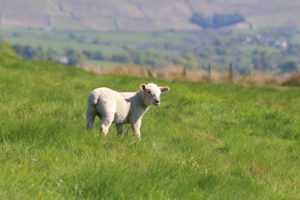 England, and I was the weird kid everyone else came to ask about getting the “power of Manon” when the movie The Craft came out.
England, and I was the weird kid everyone else came to ask about getting the “power of Manon” when the movie The Craft came out.

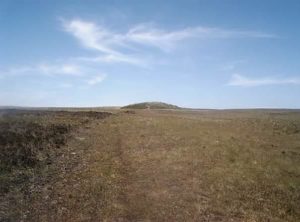
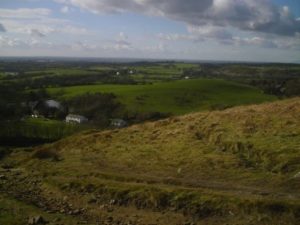 through the bottom of my boots. Then (usually at the top of a hill), I would fall to the ground to thank the hills when the knots around my heart lifted.
through the bottom of my boots. Then (usually at the top of a hill), I would fall to the ground to thank the hills when the knots around my heart lifted.
 beings that inhabit them. And a place and its inhabitants may be one way on one day, and completely different on another day. Even if you’ve been somewhere before, never assume that a place is going to be or feel the same when you go back there. Keep on top of your basic witchy skills, and
beings that inhabit them. And a place and its inhabitants may be one way on one day, and completely different on another day. Even if you’ve been somewhere before, never assume that a place is going to be or feel the same when you go back there. Keep on top of your basic witchy skills, and vending machines for favors (in exchange for some pretty subpar offerings)?
vending machines for favors (in exchange for some pretty subpar offerings)?
 over but cohabiting with. Where are you in your “neighborhood”? Who do you need to avoid pissing off and who do you need to give a little more care and attention to?
over but cohabiting with. Where are you in your “neighborhood”? Who do you need to avoid pissing off and who do you need to give a little more care and attention to?

 isolation, mine sees each tree as it is: connected through roots and mycorrhizal fungi to other trees. Trees that have been found to provide mutual aid to each other regardless of tree ‘type’.
isolation, mine sees each tree as it is: connected through roots and mycorrhizal fungi to other trees. Trees that have been found to provide mutual aid to each other regardless of tree ‘type’. The word Jötunn is thought to come from the Proto-Germanic *etunaz, which is in turn thought to be semantically connected to the Proto-Germanic *etanan, or ‘greedy’, ‘voracious’, ‘gluttonous’, ‘consuming’. Although the above snippet from Völuspá pertains to Ragnarök, it is also relevant here.
The word Jötunn is thought to come from the Proto-Germanic *etunaz, which is in turn thought to be semantically connected to the Proto-Germanic *etanan, or ‘greedy’, ‘voracious’, ‘gluttonous’, ‘consuming’. Although the above snippet from Völuspá pertains to Ragnarök, it is also relevant here. produce with little concession to human wants or needs. Productivity and profit have become king now, and people work like cattle but then struggle to survive regardless of their labor.
produce with little concession to human wants or needs. Productivity and profit have become king now, and people work like cattle but then struggle to survive regardless of their labor.



 actually been the source of many negative forms of collectivism. This is what underpins ethno-nationalism, and we don’t need to go there in order to have communities in which we share genuine bonds of friendship and love.
actually been the source of many negative forms of collectivism. This is what underpins ethno-nationalism, and we don’t need to go there in order to have communities in which we share genuine bonds of friendship and love.

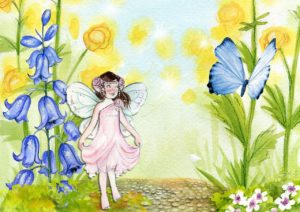
 that entertainment media is focusing on similar things. Are people really seeing that stuff, or are those things arising from the energy and belief of the consensus and becoming entities in their own right? Who knows? It’s kind of like Schroedinger’s cat in that we just don’t know and cannot know without somehow opening “the box”. But ultimately it doesn’t matter either – especially for magic workers. Because we tend to have to work with what we encounter, in the form in which we encounter it, and at the time when we encounter it regardless.
that entertainment media is focusing on similar things. Are people really seeing that stuff, or are those things arising from the energy and belief of the consensus and becoming entities in their own right? Who knows? It’s kind of like Schroedinger’s cat in that we just don’t know and cannot know without somehow opening “the box”. But ultimately it doesn’t matter either – especially for magic workers. Because we tend to have to work with what we encounter, in the form in which we encounter it, and at the time when we encounter it regardless.